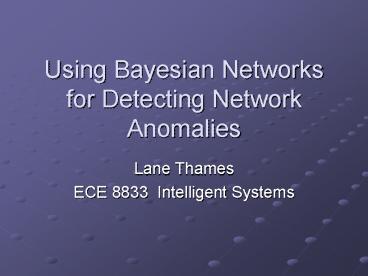Using Bayesian Networks for Detecting Network Anomalies - PowerPoint PPT Presentation
1 / 20
Title:
Using Bayesian Networks for Detecting Network Anomalies
Description:
Consume a computer's available networking bandwidth: ICMP Smurf Attack. Data Sets ... Probabilities for a Smurf Flow. Time Series of Normal Probabilities ... – PowerPoint PPT presentation
Number of Views:87
Avg rating:3.0/5.0
Title: Using Bayesian Networks for Detecting Network Anomalies
1
Using Bayesian Networks for Detecting Network
Anomalies
- Lane Thames
- ECE 8833 Intelligent Systems
2
Goals for this Project
- To see how well a Bayesian Learning Network
performs at predicting attacks within a computer
network - How do the predictions change when using pure
network data versus a combination of network and
host data
3
Common Types of Attacks
- Buffer Overflow Attacks
- Redirects Program Control Flow which causes the
computer to execute carefully injected malicious
code - Code be crafted to elevate the privileges of a
user by obtaining super user (root) privileges
4
Common Types of Attacks
- Denial of Service
- Exhaust a computers resources TCP SYN Flooding
Attack - Consume a computers available networking
bandwidth ICMP Smurf Attack
5
Data Sets
- UCI Knowledge Discovery in Databases (KDD)
archive - KDD Cup 1999 for Intrusion Detection Database
- A subset of data generated by MIT Lincoln Labs
that simulated a military networking environment
(4 weeks _at_ 22 hrs/day of data)
6
Data Sets
- Contained data for training and separate, labeled
data for testing - The test data contained noise because it
contained attack data that was not included in
the training data
7
Data Sets
- 22 total attack types were generated and were
interlaced with normal traffic flows - Types of Attacks within the data
- Denial of Service
- Unauthorized remote access
- Local user to super user access
- Probing Reconnaissance and network mapping
8
Data Sets
- 41 Features that could be used as Random
Variables within a Bayesian Network - Host Based Features
- Network Based Features
9
Feature Set Snippet
10
Tool Boxes Used for the Project
- BN Power Constructor
- Developed by J. Cheng at the University of
Alberta in Canada - Tool for generating possible network structures
given a set of training data - Exports the structure in DNE Bayesian network
file format
11
Tool Boxes Used for the Project
- NeticaJ by Norsys
- Java based development library
- Used to build the Bayesian network codebase for
this project - Imports structure in DNE file format
- Contains functions for doing inference and
learning CPTs given a set of training data
12
Implementation
- 2 types of structures used
- Combination of network and host based features
- Only network based features
13
Host/Network Structure
14
Host/Network Test Results
- Using the Noisy Test Data
- 65,505 Total Test Cases
- 65,019 Correctly Classified
- 99.26 Classification Accuracy
15
Probabilities for a Single Flow
16
Probabilities for a Smurf Flow
17
Time Series of Normal Probabilities
18
Network Features Structure
19
Network Variables Test Results
- 62,047 Total Noisy Test Cases
- 59,734 Correctly Classified
- 96.27 Classification Accuracy
20
Conclusion
- The Bayesian Network produced very impressive
results - The reduced structure only relied on network
data, and only suffered from a small decrease in
accuracy - Term project will extend this to incorporate a
SOM variable































